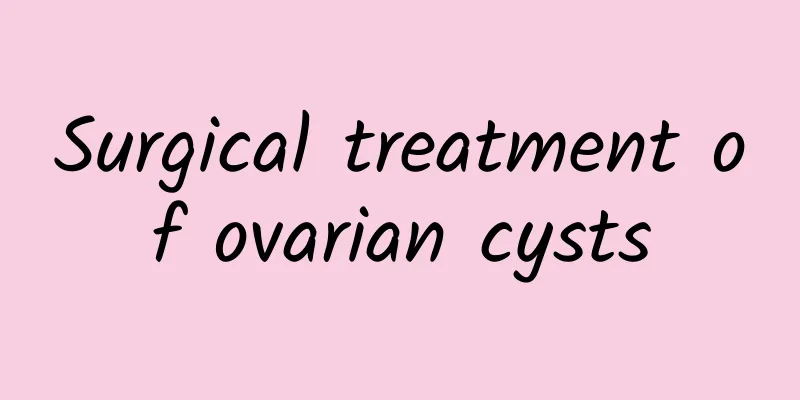Complete list of treatments for congenital absence of vagina

|
Complete treatment method for congenital absence of vagina. During the differentiation and formation of sexual organs at about 7-10 weeks of embryonic period, after the two paramesonephric ducts merge, their tail ends are blocked or stagnant and fail to develop downward, resulting in congenital absence of vagina. The vagina is a receptacle for sexual intercourse and semen. Congenital absence of vagina affects the entry and storage of semen or sperm in the vagina, or affects the function of normal sperm, resulting in infertility. Therefore, timely treatment is required. So how to treat congenital absence of vagina? The timing and method of treatment for congenital absence of vagina should be determined based on the development of the patient's uterus. 1. Timing of treatment for congenital absence of vagina: After detailed examination, if the patient has a nearly normal uterus and normal ovarian function, surgery should be performed after the menstrual period to facilitate menstrual blood drainage and sexual intercourse. After treatment, there is hope for intrauterine pregnancy. If the patient has no uterus or primordial uterus and is not likely to have children, it is best to perform artificial vaginoplasty before or after marriage to mainly solve the problem of sexual life. 2. Treatment of congenital absence of vagina (1) Top-pressure method: For those who are infertile and have a partially sac-like vagina, local top-pressure method can be tried according to the patient's wishes. A round and blunt mold like the bottom of a test tube can be used for long-term self-pressure. Sexual intercourse can also be gradually deepened. If the patient is not satisfied, it also creates better conditions for surgery. (2) Vaginoplasty: There are many types of vaginoplasty, such as labia minora flap vaginoplasty, inner thigh flap vaginoplasty, sigmoid colon vaginoplasty, peritoneal vaginoplasty, etc. If the woman becomes pregnant after surgery, she should be closely monitored, and a cesarean section should be chosen if the due date is close. The principle of treating congenital absence of vagina is to reconstruct the vagina. There are various methods for artificial vaginal formation, including non-surgical treatment, which is to gradually push the closed vestibule mucosa in the normal vaginal position along the vaginal axis to the head end to form an artificial cavity. Surgical treatment mainly separates the urethra, bladder and rectum to form an artificial cavity, and uses different methods to find a suitable cavity wound cover to reconstruct the vagina. There are many surgical methods for congenital absence of vagina. The choice of surgery is mainly based on the patient's local anatomy of the vulva and other specific clinical conditions. In recent years, with the progress of microsurgery, vascularized myocutaneous flaps have been used to cover the cavity, which has also opened up a new way for this surgery. When the paramesonephric duct is seriously dysplastic, there is often incomplete renal rotation, low migration of the kidney, or migration to the pelvic cavity, forming pelvic kidney, horseshoe kidney, transboundary renal ectopia (two kidneys are located on the same side of the body), renal agenesis, renal insufficiency and other urinary tract malformations. Therefore, when vaginoplasty is performed on cases of congenital absence of vagina, intravenous pyelography should be performed before the operation to be alert to the presence of the above malformations and avoid surgical injuries. In addition, patients with this disease also have bone deformities, accounting for about 10%, including spina bifida, sacral occult fracture, vertebral fusion and spinal non-segmentation. |
<<: What are the methods of traditional Chinese medicine for treating congenital absence of vagina?
>>: Treatment and progress of congenital absence of vagina
Recommend
The three troublemakers with three highs! Lycopene Antioxidant Helps Anti-Aging
Hypertension, high blood lipids and diabetes (col...
How to cure congenital absence of vagina
How to cure congenital absence of vagina? Althoug...
The most important way to prevent vaginitis
Among gynecological diseases, vaginitis is a very...
How serious is the danger of pelvic inflammatory disease?
1. Cause ectopic pregnancy Due to pelvic congesti...
How much does it cost to cure pelvic peritonitis?
Pelvic peritonitis refers to inflammation of the ...
What are the ways to prevent vaginitis?
What preventive measures do you know about vagini...
Cold feet cause your ankles to get thicker! 5 bad habits that make you have elephant legs
For women, it is important to have beautiful feet...
What are the consequences of miscarriage? There are 4 major hazards
After a miscarriage, women are prone to secretion...
What tests should be done if menstruation is not coming?
Patients who often have delayed or absent menstru...
Uterine fibroids remedies
Uterine fibroids are a relatively common benign t...
What are the triggering factors of threatened abortion?
What are the predisposing factors of threatened a...
What causes ovarian cysts?
How do you get an ovarian cyst? What causes it? 1...
What kind of exercise is better after entering middle age? Exercise your "white muscles"!
How old are you this year? For people, 40 is a sp...
What causes uterine fibroid pain? Does uterine fibroid pain
What causes pain in uterine fibroids? Does uterin...
Do uterine fibroids affect pregnancy?
Do uterine fibroids affect pregnancy? Uterine fib...









